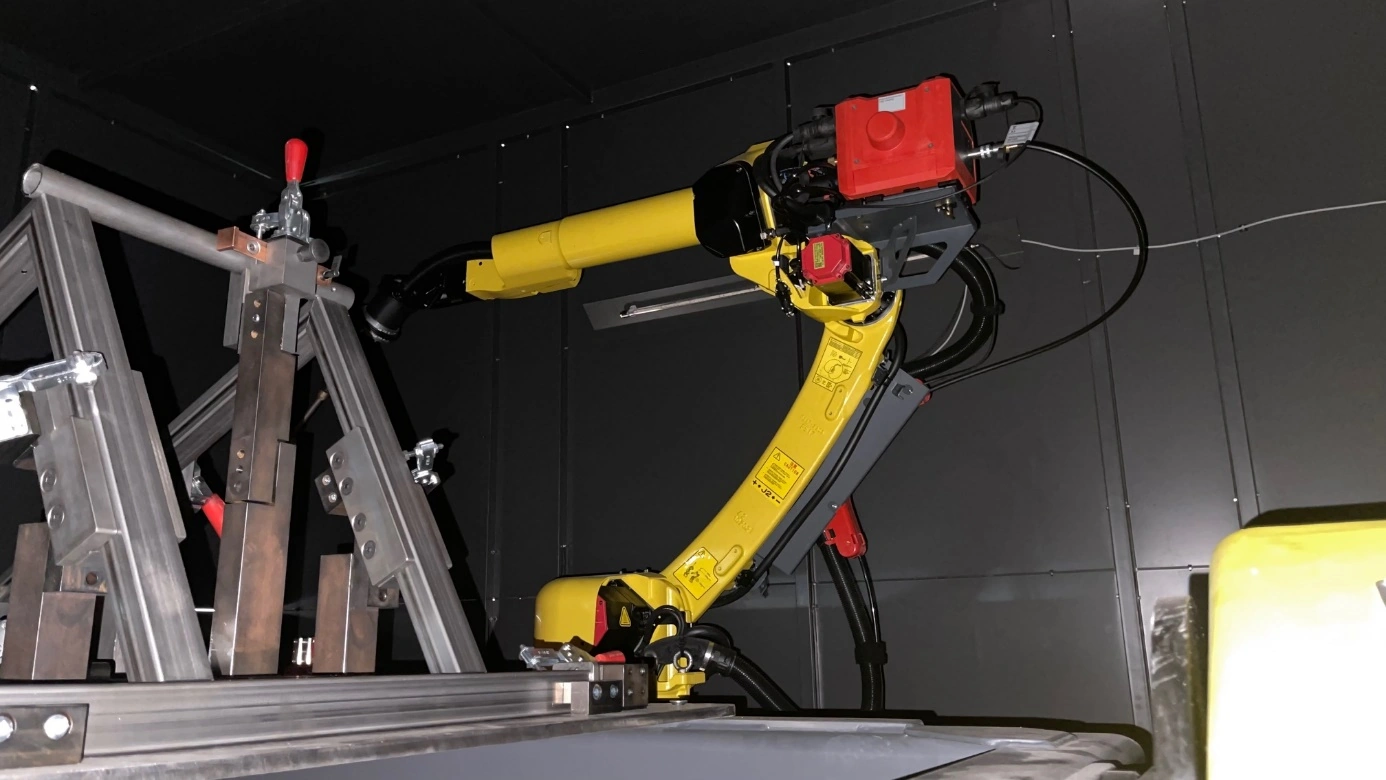One of the biggest breakthroughs in modern industrial manufacturing is robotic welding which not only increases productivity, but also plays a key role in ensuring quality. But what exactly is robotic welding, how does it work, and in which industries is it most used? In this article, we present the most important information in detail and how significant the role of sheet metal processing and metal structure manufacturing .
What is robotic welding?
Robotic welding is an automated manufacturing technology in which industrial robots perform welding tasks. These robots can be programmed and use various welding techniques (e.g. arc welding, spot welding, laser welding) can be applied. Robotic welding works with high precision and repeatability, thereby minimizing human errors.
Advantages of robotic welding
- Precision and quality: Industrial robots are capable of extremely precise movements, creating smooth and high-quality weld seams .
- Speed: Robots are faster than manual welders, especially when dealing with a high volume of repetitive tasks.
- Cost-effectiveness: Although initial investment costs may be high, in the long run, productivity gains and reduced errors can lead to significant savings.
- Safety: The use of robots reduces human exposure to hazardous work environments such as high temperatures or welding gases.
How robotic welding works
Robotic welding systems generally consist of the following main components:
- Industrial robot arm: This is the robot’s “hand” that moves the weld head.
- Welding equipment: Includes tools suitable for welding technique (e.g. MIG, TIG or laser).
- Control system: A unit that programs and controls the robot.
- Sensors and cameras: To ensure automatic fault detection and precision.
Where is robotic welding used?
- Automotive: In the automotive industry, it is often used for spot welding (e.g. joining body parts) and arc welding (e.g. manufacturing chassis parts).
- Metal industry: In the manufacture of structural metals, pipelines and tanks, where heavy-duty and precise weld seams are required.
- Mechanical engineering: For the manufacture of industrial equipment and parts for large machinery.
- Aerospace: For welding tasks that require high precision and reliability.
- Electronics industry: For welding small, precise components such as battery cells.
Application of robotic welding in the metal industry
Robotic welding In many areas of industry, especially in the metal industry, it is an increasingly widespread technology. In the production of structural metals, pipelines and tanks, it is particularly important to create heavy-duty and precise weld seams, which robotic welding systems can provide efficiently and reliably.
Why is robotic welding advantageous in metal structure manufacturing?
Superior accuracy and repeatability
Thanks to the programming of robots, each weld seam is made according to the same standards with minimal error. This is especially important for structural elements and pressure vessels, where the quality of seams is critical.
Increased productivity
Robots can work continuously without human fatigue. This allows the production process to be faster and more efficient, reducing production time.
Load-optimised seams
Robotic welding allows the specific behaviour of the material to be taken into account, thus optimising the strength and durability of seams, which is especially important for pipelines and tanks.
Cost effectiveness
Although the introduction of robotic welding technology requires a significant initial investment, it can be more cost-effective in the long run as the number of rejects is reduced and labour requirements can be optimized.
Safe working environment
The heat, light and gases released during welding work can be dangerous for human workers. Robots take on these hazardous tasks, reducing risks to the working environment.
Spheres of application
Robotic welding supports metallurgical production in many applications:
- Manufacture of structural elements: For example, bridges, building frames or larger machine structures.
- Pipelines: Manufacture of pipelines for the oil and gas industry, where leakproofness of seams is critical.
- Tanks: Pressure vessels, liquid containers or heat exchangers where welding quality affects operational safety and efficiency.
Most common robotic welding technologies
MIG/MAG welding (metal gas arc welding)
This is the most common process, which is excellent for welding steel and aluminum structures. The precise control of the robots enables precise seams to be formed.
TIG welding (tungsten electrode arc welding)
It is mainly used for thinner materials and more demanding seams. It is especially important for stainless steel and special alloys.
Spot welding
It is excellent for joining thin sheets of steel, for example in the automotive industry and tank production.
Laser welding
Extremely precise and fast process that uses a high-energy laser beam. Ideal for complex geometries and thin materials.
Advanced technologies in robotic welding
- Automatic seam tracking: The robot uses sensors to monitor the seam position and correct the weld path.
- Artificial intelligence and machine learning: Robotic welders are increasingly able to learn from repetitive tasks and improve seam quality.
- Remote control and monitoring: Operators can monitor the welding process in real time and intervene if necessary.
The introduction of robotic welding in the metal industry not only increases productivity, but also makes it possible to perform precision jobs that were previously difficult to perform.
Concluding thoughts
Robotic welding in the metal industry It has been given an outstanding role, as it not only increases the efficiency of production processes, but also raises quality to a higher level. In various sectors of the industry – be it structural components, pipelines or tanks – robotic welding provides the precision, reliability and strength required to produce safe and durable products.
Robotic systems Due to its continuous operation, repeatability and reduction of labour demand, they can result in significant cost savings in the long run. In addition, since robots are better able to avoid errors than human workers, continuous optimization and improvement of production processes is possible.
Robotic welding is therefore not just a new technological trend, but has become an essential tool in the metal industry, bringing numerous benefits to both manufacturers and end users. Precision welding, cost-effectiveness, a safe working environment and increased industry competitiveness are all contributing to robotic welding becoming a key player in the manufacturing processes of the future.
If you are looking for a company that is at the forefront of robotic welding, then do not hesitate to contact us. Our company uses the In addition to metal structure manufacturing and sheet metal processing, it is able to help meet the needs of its partners in countless areas.




